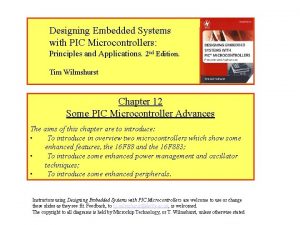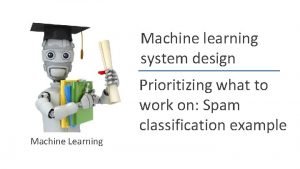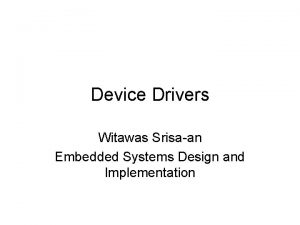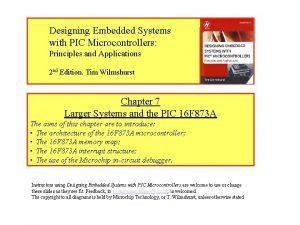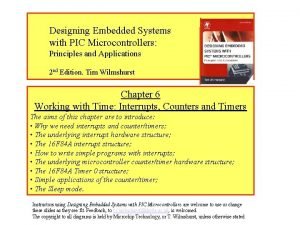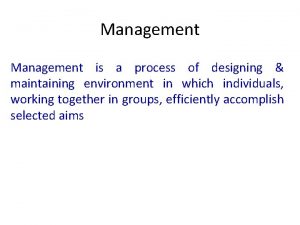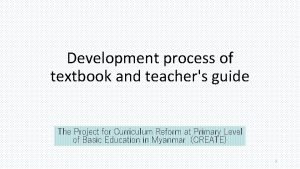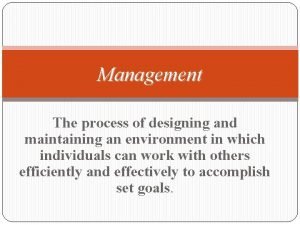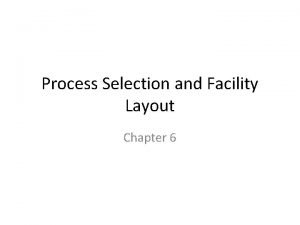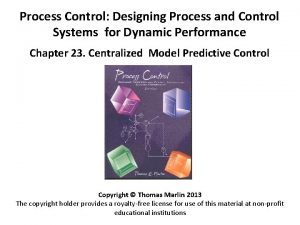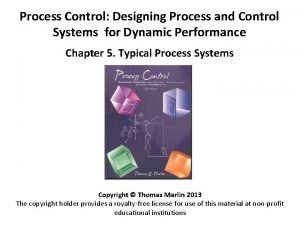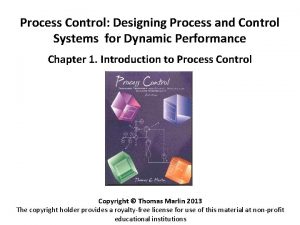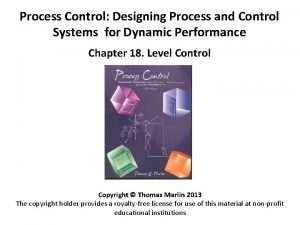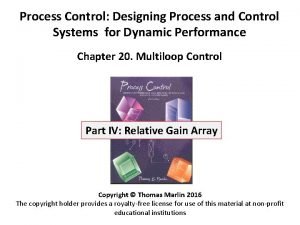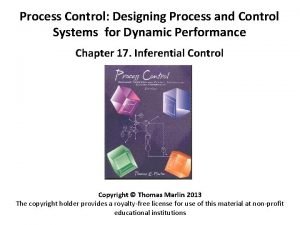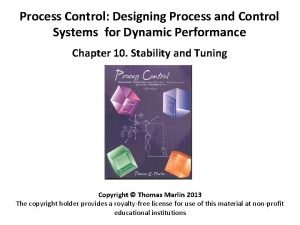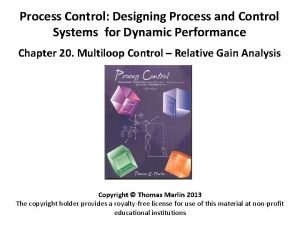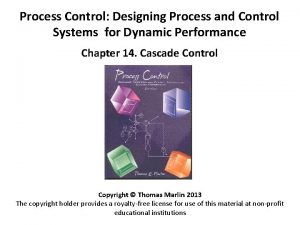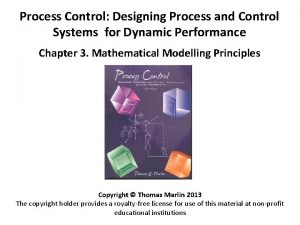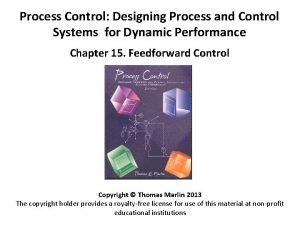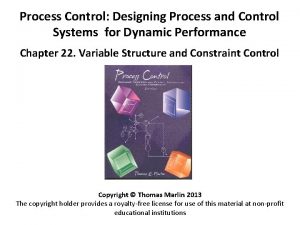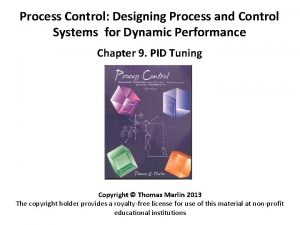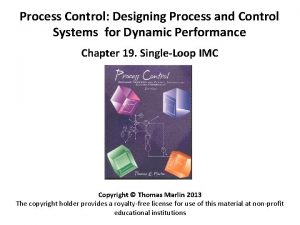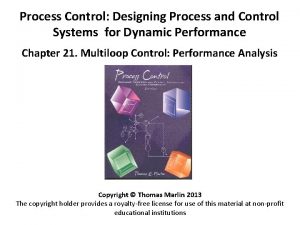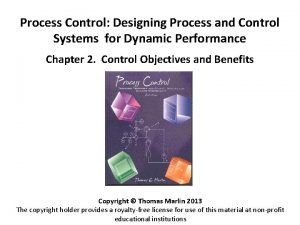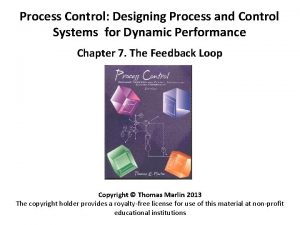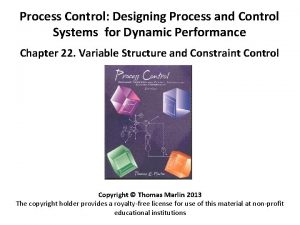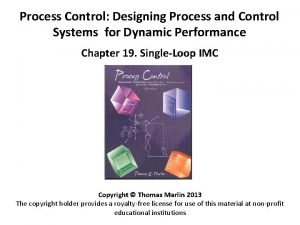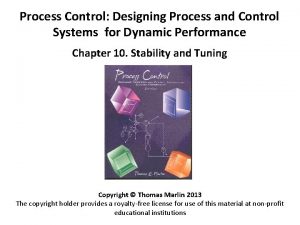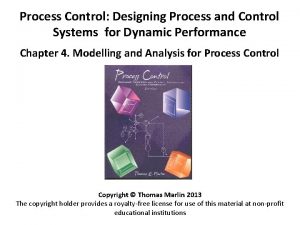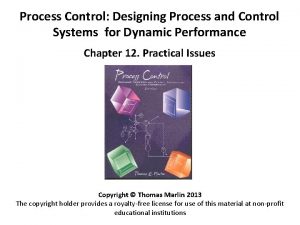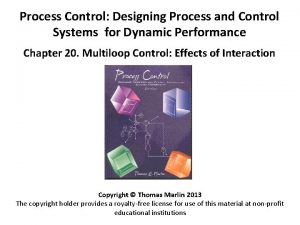Process Control Designing Process and Control Systems for
















































- Slides: 48

Process Control: Designing Process and Control Systems for Dynamic Performance Chapter 11. Digital Control Copyright © Thomas Marlin 2013 The copyright holder provides a royalty-free license for use of this material at non-profit educational institutions

CHAPTER 11: DIGITAL CONTROL When I complete this chapter, I want to be able to do the following. • Identify examples of analog and digital computation and signal transmission. • Program a digital PID calculation • Select a proper execution rate for a feedback controller. • Tune a digital PID

CHAPTER 11: DIGITAL CONTROL Outline of the lesson. • Brief history of control equipment • Sampling the measurement • Digital PID calculation • Effect of digital execution period on tuning and performance

CHAPTER 11: DIGITAL CONTROL A BRIEF HISTORY OF PROCESS CONTROL • A little history helps us to understand the common approaches to process control. The realities of available equipment have shaped theory and practice of process control. • While digital technology has revolutionized what is possible today, equipment has a life of many decades. Therefore, we see older approaches in most plants, and will for a long time. • Let’s start from about the late 18 th and early 19 th century to today. What happened that “got things going”?

CHAPTER 11: DIGITAL CONTROL Making the steam engine work all the time governor Inventors wanted to control the pressure of the boiler and the speed of the device driven by the steam (using a governor). People experienced - Explosions! - Unstable behavior And control engineering was born! http: //oldenginehouse. users. btopenworld. com/watt. htm

CHAPTER 11: DIGITAL CONTROL Manual Operation • Manual operation • Mechanical devices • Pneumatic devices • Electronic devices People know more than machines, so leave decisions to them. Temperature indicator Should I adjust the valve or should I run? • Digital calculations • Digital calc. & communication Emergency cooling

CHAPTER 11: DIGITAL CONTROL Mechanical Device • Manual operation • Mechanical devices The value of the variable is represented by position of equipment. How do I change the set point? Location of the fulcrum determines the gate/ level • Pneumatic devices • Electronic devices • Digital calculations • Digital calc. & communication Raising and lowering the gate affects the flowin Float measures the liquid level

CHAPTER 11: DIGITAL CONTROL Pneumatic Device • Manual operation The value of the variable is proportional to air pressure (50 - 150 C = 3 -15 psi). • Mechanical devices • Pneumatic devices How do I perform the PID calculation? v 1 TC • Electronic devices • Digital calculations • Digital calc. & communication v 2 The signal is 3 -15 psi air pressure in a pipe. Air pressure moves flexible diaphragm

CHAPTER 11: DIGITAL CONTROL Pneumatic & Electronic Devices • Manual operation Principle of analog computation! • Mechanical devices • Pneumatic devices • Electronic devices • Digital calculations • Digital calc. & communication Build a physical system that (approximately) obeys the same model. • Pneumatic - force balance (Newton’s laws) • Electronic - current balance (Kirkoff’s laws) I wonder what these devices look like.

CHAPTER 11: DIGITAL CONTROL Analog computation! Pneumatic Electronic From Harriott, P. , Process Control, Mc. Graw-Hill, New York, 1964

CHAPTER 11: DIGITAL CONTROL Electronic Device • Manual operation The variable is proportional to current or voltage (50 - 150 C = 4 - 20 m. A). • Mechanical devices • Pneumatic devices I’ll use analog computation again. v 1 TC • Electronic devices • Digital calculations • Digital calc. & communication v 2 The signal is 4 -20 m. A transmitted by wire. Current converted to air pressure to affect valve

CHAPTER 11: DIGITAL CONTROL Digital Calculation • Manual operation Digital calculations with electronic transmission. • Mechanical devices v 1 • Pneumatic devices • Electronic devices • Digital calculations • Digital calc. & communication We’ll soon see how to calculate PID digitally. TC Digital PID v 2 The signal is 4 -20 m. A transmitted by wire. Current converted to air pressure to affect valve

CHAPTER 11: DIGITAL CONTROL Digital Calculation & Communication • Manual operation • Mechanical devices • Pneumatic devices • Electronic devices • Digital calculations • Digital calc. & communication Digital calculations with transmission by local area network. Sensor and valve can have microprocessors too! We soon see how to calculate PID digitally. v 1 Digital PID TC v 2 The signal transmitted digitally. converted to air pressure to affect valve

CHAPTER 11: DIGITAL CONTROL Digital control employs a distributed computing network Why?

CHAPTER 11: DIGITAL CONTROL Digital control employs a distributed computing network

CHAPTER 11: DIGITAL CONTROL Let’s remember that control is performed many places; locally and remotely by people and equipment. Central control room Sensors, local indicators, and valves in the process. Some actions and automation done here. Displays of variables, calculations, and commands to valves are in the centralized control center.

CHAPTER 11: DIGITAL CONTROL A rough indication of the use of various devices for control calculations for new industrial process control systems.

CHAPTER 11: DIGITAL CONTROL • Manual operation • Mechanical devices The techniques presented will be applicable for digital sampling and calculation. Transmission can be electronic or digital. Periodically, the measurement is sampled and a calculation is performed. • Pneumatic devices • Electronic devices • Digital calculations • Digital calc. & communication v 1 TC Digital PID v 2

CHAPTER 11: DIGITAL CONTROL Not much information lost What happened here?

CHAPTER 11: DIGITAL CONTROL Aliasing: Sampling much slower than the measurement changes causes significant loss of information. Engineer should design for sampling “fast enough”. What happened here? ALIASING

CHAPTER 11: DIGITAL CONTROL We “hold” the last sampled value between control executions. 1. 5 Signal after the zero-order hold, samples every 2. 5 time units 0. 9 0. 3 Continuous signal -0. 3 Does the sample/ hold change the dynamics? -0. 9 -1. 5 0 5 10 15 Time 20 25 30

CHAPTER 11: DIGITAL CONTROL The red line is the continuous approximation of the signal after the sample & hold. This shows that the effect is to introduce a “dead time” of about t/2. Continuous signal that is approximately the output of the hold. t/2 due to sampling

CHAPTER 11: DIGITAL CONTROL We have a sample of values; CV 1, CV 2, …. , CVN Proportional: Integral: Derivative: Hint: How would you estimate each mode using numerical methods?

CHAPTER 11: DIGITAL CONTROL We have a sample of values; CV 1, CV 2, …. , CVN Proportional: Integral: Calculated every time the controller is executed. Derivative:

CHAPTER 11: DIGITAL CONTROL We have a sample of values; CV 1, CV 2, …. , CVN Proportional: Integral: Derivative: Calculated every time the controller is executed. • t = constant • How many elements in sum?

CHAPTER 11: DIGITAL CONTROL We have a sample of values; CV 1, CV 2, …. , CVN Proportional: Integral: Derivative: Efficient calculation in realtime!

CHAPTER 11: DIGITAL CONTROL We have a sample of values; CV 1, CV 2, …. , CVN Proportional: Integral: Calculated every time the controller is executed. Derivative:

CHAPTER 11: DIGITAL CONTROL We have a sample of values; CV 1, CV 2, …. , CVN “I” is sometimes called the bias. Calculated only when the controller is turned on, N=1. Thereafter, I is constant Bumpless transfer: No change to the MV when controller is first executed

CHAPTER 11: DIGITAL CONTROL Digital PID, positional form calculates the output to the final element Put all modes together.

CHAPTER 11: DIGITAL CONTROL Digital PID, Velocity form - Alternatively, we can calculate the change in the signal at every execution.

CHAPTER 11: DIGITAL CONTROL What is the effect of digital execution of the PID controller on tuning and performance? Hint: things don’t get better by slowing the loop. FS solvent FA Continuous tuning Kc = 30 TI = 11 Td = 0. 80 pure A AC SP

CHAPTER 11: DIGITAL CONTROL S-LOOP plots deviation variables (IAE = 12. 2909) 1 Continuous PID 0. 5 0 0 1 0. 5 0 50 100 150 S-LOOP plots deviation variables (IAE = 20. 0491) 1. 5 Controlled Variable 1. 5 200 250 0 Digital PID, t=5 50 100 Manipulated Variable 30 20 10 0 0 50 100 150 200 0 50 100 250 Time S-LOOP plots deviation variables (IAE = 37. 1005) S-LOOP plots deviation variables (IAE = 45. 5197) 2 Controlled Variable 150 20 0 250 2 1. 5 1 Digital PID, t=10 0. 5 0 50 100 150 200 1. 5 1 Digital PID, t=15 0. 5 0 250 0 50 100 250 CONCLUSION: We should retune the controller when the execution is slow compared with the feedback dynamics! 150 200 250 80 Manipulated Variable 60 40 20 0 150 Time Manipulated Variable 250 40 Time 0 200 60 40 0 150 Time 50 100 150 Time 200 250 60 40 20 0 -20 0 50 100 Time

CHAPTER 11: DIGITAL CONTROL S-LOOP plots deviation variables (IAE = 12. 2909) 1 Continuous PID 0. 5 0 0 1 0. 5 0 50 100 150 S-LOOP plots deviation variables (IAE = 20. 0491) 1. 5 Controlled Variable 1. 5 200 250 0 50 Manipulated Variable 10 0 0 50 100 150 200 250 t = 0. 33( + ) >> 0. 05 ( + ) 60 40 20 100 Time 30 Digital PID, t=5 40 20 0 0 50 Time 100 150 200 Time Guideline for selecting the execution time: To prevent degradation of control loop performance, select a controller execution time of t 0. 05( + ). Note: Typical sample period for chemical process control is 1/3 -1/2 second. Much faster is possible, if needed. 250

CHAPTER 11: DIGITAL CONTROL Modified PID tuning for digital controllers - this is a guideline that usually works adequately. Continuous signal that is approximately the output of the hold. t/2 due to sampling We learned that sampling introduces an additional dead time of about t/2. 1. 2. 3. 4. 5. Obtain model, usually using empirical method Determine the sample period, t 0. 05( + ), if possible Recalculate the dead time as ’ = + t/2 Calculate tuning using continuous method Implement and fine tune as needed

CHAPTER 11: DIGITAL CONTROL Let’s apply this guideline for the three-tank mixer with a long sample time = 15 minutes. FS solvent FA pure A AC Process reaction curve Tuning from chart Kp = 0. 039 %A/%open Kc = ? ? = 5. 5 + ? ? = ? ? min TI = ? ? = 10. 5 min Td = ? ?

CHAPTER 11: DIGITAL CONTROL The performance is about as good as possible with this very long sampling time! Would you fine tune further? S-LOOP plots deviation variables (IAE = 20. 0383) Kc = 20 TI = 14 Td = 2. 35 IAE increased from 12. 2 to 20+ 1 0. 5 0 0 50 100 150 200 250 Time 50 Manipulated Variable Tuning from chart Controlled Variable 1. 5 40 30 20 10 0 0 50 100 Time

CHAPTER 11: DIGITAL CONTROL If the PID is no better in digital form, why did we spend decades of engineering time and billions of dollars converting the world’s control to digital?

CHAPTER 11: DIGITAL CONTROL Distillate Light key Why did we convert the world’s control to digital - Complex controllers 0. 995 0. 99 0. 985 0. 98 0 FR Good performance! 50 100 Time 150 200 FV Bottoms Light Key 0. 04 0. 035 0. 03 Almost no disturbance! Improved performance can be achieved with algorithms that optimize the path to the set point, every controller execution! 0. 025 0. 02 0 (See Chapters 19 and 23) 50 100 Time 150 200

CHAPTER 11: DIGITAL CONTROL Why did we convert the world’s control to digital - Process monitoring We have a digital history of measurements for • Recall at any time for trouble shooting • Calculation of process performance indicators, heat transfer coefficients, reactor yields, energy/kg of product, and so forth • Excellent graphical displays with data in context of process schematic (See Chapter 26)

CHAPTER 11: DIGITAL CONTROL Why did we convert the world’s control to digital - Process optimization Best suction pressure? Best reactor conversions? Best product/ recycle purities? Best feed rates, each feed type (See Chapter 26)

CHAPTER 11: DIGITAL CONTROL Why did we convert the world’s control to digital -Diagnostics We have digital monitors at sensor, controller and valve! • Compare signal to valve with actual valve position - report significant errors • Diagnose problems with sensor (voltage, etc. ) • Do not take feedback control action on questionable loop - alarm operator And many other reasons that digital is a winner.

CHAPTER 11: DIGITAL CONTROL, WORKSHOP 1 1. Select all of the appropriate answers. Mechanical implementation of feedback control employs a. Digital computation b. Analog computation c. Neither a nor b d. Both a and b 2. A digital PID controller is operating “in automatic”, i. e. , it is calculating the signal to the final element. You are fine tuning the loop. You change the controller gain by -30% of its original value. Describe what happens.

CHAPTER 11: DIGITAL CONTROL, WORKSHOP 2 You are tuning the temperature controller shown in the figure. You have determined the dynamic model below. Determine the PID tuning for this loop for execution periods below and simulate the results using S_LOOP. • t = 0. 10 • t = 1. 0 • t = 5. 0 (All times are in minutes. ) v 1 TC v 2

CHAPTER 11: DIGITAL CONTROL, WORKSHOP 3 Develop a table with advantages and disadvantages for the six control equipment categories for many important issues.

CHAPTER 11: DIGITAL CONTROL When I complete this chapter, I want to be able to do the following. • Identify examples of analog and digital computation and signal transmission. • Program a digital PID calculation • Select a proper execution rate for a feedback controller. • Tune a digital PID Lot’s of improvement, but we need some more study! • Read the textbook • Review the notes, especially learning goals and workshop • Try out the self-study suggestions • Naturally, we’ll have an assignment!

CHAPTER 11: LEARNING RESOURCES • SITE PC-EDUCATION WEB - Instrumentation Notes - Interactive Learning Module (Chapter 11) - Tutorials (Chapter 11) • Software Laboratory, S_LOOP - You can simulate a PID loop with continuous of digital control to determine the effect of execution period.

CHAPTER 11: SUGGESTIONS FOR SELF-STUDY 1. Find some process reaction curve plots in Chapters 3 -5. Determine the maximum PID execution period. Then, for a controller execution period ten times the minimum, determine the tuning for PID and PI controllers using the tuning charts. 2. Using S_LOOP, simulate the system(s) in question 1. 3. Develop a flowchart for an excellent computer program to calculate the PID control. This should be a subroutine that can be called for every controller in the plant.

CHAPTER 11: SUGGESTIONS FOR SELF-STUDY 4. Take an inventory of your house and identify analog and digital control systems. 5. Develop a simulation that accepts a continuous signal and determines the output of a zero-order hold and firstorder hold.
 Designing embedded systems with pic microcontrollers
Designing embedded systems with pic microcontrollers Machine learning system design examples
Machine learning system design examples Designing device drivers for embedded systems
Designing device drivers for embedded systems Designing embedded systems with pic microcontrollers
Designing embedded systems with pic microcontrollers Pic architecture diagram
Pic architecture diagram The process of designing and maintaining an environment
The process of designing and maintaining an environment Textbook development process
Textbook development process The process of designing and maintaining an environment
The process of designing and maintaining an environment Layout
Layout Closeness rating examples
Closeness rating examples Process control systems
Process control systems Process and product control
Process and product control Formuö
Formuö Typiska novell drag
Typiska novell drag Tack för att ni lyssnade bild
Tack för att ni lyssnade bild Returpilarna
Returpilarna Shingelfrisyren
Shingelfrisyren En lathund för arbete med kontinuitetshantering
En lathund för arbete med kontinuitetshantering Underlag för särskild löneskatt på pensionskostnader
Underlag för särskild löneskatt på pensionskostnader Personlig tidbok
Personlig tidbok Sura för anatom
Sura för anatom Densitet vatten
Densitet vatten Datorkunskap för nybörjare
Datorkunskap för nybörjare Boverket ka
Boverket ka Debatt mall
Debatt mall Autokratiskt ledarskap
Autokratiskt ledarskap Nyckelkompetenser för livslångt lärande
Nyckelkompetenser för livslångt lärande Påbyggnader för flakfordon
Påbyggnader för flakfordon Tryck formel
Tryck formel Publik sektor
Publik sektor I gullregnens månad
I gullregnens månad Presentera för publik crossboss
Presentera för publik crossboss Jiddisch
Jiddisch Bat mitza
Bat mitza Treserva lathund
Treserva lathund Epiteltyper
Epiteltyper Bästa kameran för astrofoto
Bästa kameran för astrofoto Centrum för kunskap och säkerhet
Centrum för kunskap och säkerhet Programskede byggprocessen
Programskede byggprocessen Bra mat för unga idrottare
Bra mat för unga idrottare Verktyg för automatisering av utbetalningar
Verktyg för automatisering av utbetalningar Rutin för avvikelsehantering
Rutin för avvikelsehantering Smärtskolan kunskap för livet
Smärtskolan kunskap för livet Ministerstyre för och nackdelar
Ministerstyre för och nackdelar Tack för att ni har lyssnat
Tack för att ni har lyssnat Mall för referat
Mall för referat Redogör för vad psykologi är
Redogör för vad psykologi är Matematisk modellering eksempel
Matematisk modellering eksempel Tack för att ni har lyssnat
Tack för att ni har lyssnat
